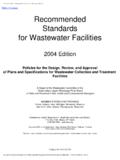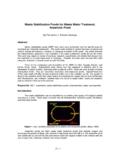Transcription of Methods of Removing Heavy Metals from Industrial Wastewater
1 Journal of Multidisciplinary Engineering Science Studies (JMESS) ISSN: 2912-1309 Vol. 1 Issue 1, November - 2015 JMESSP13420004 12 Methods of Removing Heavy Metals from Industrial Wastewater Gunatilake Department of Natural Resources Sabaragamuwa University of Sri Lanka Belihuloya, Sri Lanka e-mail: Abstract Methods for treating Industrial Wastewater containing Heavy Metals often involve technologies for reduction of toxicity in order to meet technology-based treatment standards. This article was focused on the recently developed and newly applicable various treatment processes for the removal of Heavy Metals from Industrial Wastewater .
2 Physico-chemical removal processes such as; adsorption on new adsorbents, ion exchange, membrane filtration, electrodialysis, reverse osmosis, ultrafiltration and photocatalysis were discussed. Their advantages and drawbacks in application were evaluated. In the processes of biological treatments microorganisms play a role of settling solids in the solution. Activated sludge, trickling filters, stabilization ponds are widely used for treating Industrial Wastewater . Bioadsorption is a new biological method and various low cost bioadsorbents (agricultural waste , forest waste , Industrial waste , algae etc.)
3 Are used for maximum removal of Heavy Metals from Wastewater . Bioadsorption techniques are eco friendly best solutions for Removing Heavy Metals from Wastewater rather than physic-chemical Methods . But chemical Methods are most suitable treatments for toxic inorganic compounds produced from various industries which cannot removed from any biological and physical techniques. Keywords Heavy Metals ; removal techniques; bioadsorption; physico-chemical treatments I. INTRODUCTION The environmental issues due to globalization and rapid industrialization are becoming more and more nuisance for human being.
4 Therefore efficient and effective Methods are needed especially for chemical industries. Heavy Metals present in Wastewater and Industrial effluent is major concern of environmental pollution. Heavy Metals are generally considered those whose density exceeds 5 g per cubic centimeter. Most of the elements falls into this category are highly water soluble, well-known toxics and carcinogenic agents. Heavy Metals are considered to be the following elements: Copper, Silver, Zinc, Cadmium, Gold, Mercury, Lead, Chromium, Iron, Nickel, Tin, Arsenic, Selenium, Molybdenum, Cobalt, Manganese, and Aluminum.
5 They represent serious threats to the human population and the fauna and flora of the receiving water bodies ([1]. They can be absorbed and accumulated in human body and caused serious health effects like cancer, organ damage, nervous system damage, and in extreme cases, death. Also it reduces growth and development. Industrial Wastewater streams containing Heavy Metals are produced from different industries. Heavy Metals such as cadmium, zinc, lead, chromium, nickel, copper, vanadium, platinum, silver, and titanium are generated in electroplating, electrolysis depositions, conversion-coating, and anodizing-cleaning, milling, and etching industries.)
6 Significant amount of Heavy Metals wastes like Tin, lead, and nickel result from printed circuit board (PCB) manufacturing. Wood processing industries where a chromated copper-arsenate wood treatment produces arsenic containing wastes; inorganic pigment manufacturing producing pigments contain chromium compounds and cadmium sulfide; petroleum refining generates conversion catalysts contaminated with nickel, vanadium, and chromium; and photographic operations producing film with high concentrations of silver and ferrocyanide. All of these generators produce a large quantity of wastewaters, residues, and sludge that can be categorized as hazardous wastes requiring extensive waste treatment [2].
7 As the low amounts of these Metals are highly toxic, removal of Heavy Metals from Wastewater has recently become the subject of considerable interest owing to strict legislations. Wastewater regulations were established to minimize human and environmental exposure to hazardous chemicals. These include limits on the types and concentration of Heavy Metals that may be present in the discharged Wastewater . The Maximum Contaminated Level (MCL) standards, for those Heavy Metals , established by USEPA [3] are summarized in Table 1. Therefore it is necessary to treat metal contaminated Wastewater prior to its discharge to the environment.
8 Heavy metal removal from inorganic effluent can be achieved by conventional treatment processes. Removal of Heavy Metals from Industrial wastewaters can be accomplished through various treatment options, including such unit operations as chemical precipitation, coagulation, complexation, activated carbon adsorption, ion exchange, solvent extraction, foam flotation, electro-deposition, cementation, and membrane operations. This paper describes these various treatment strategies and methodologies employed for Heavy metal removal. Journal of Multidisciplinary Engineering Science Studies (JMESS) ISSN: 2912-1309 Vol.
9 1 Issue 1, November - 2015 JMESSP13420004 13 TABLE 1 The MCL standards for the most hazardous Heavy Metals (Babel and Kurniawan, 2003) Heavy metal Toxicities MCL(mg/L) Arsenic Cadmium Chromium Copper Nikel Zinc Lead Mercury Skin manifestations, visceral cancers, vascular disease Kidney damage, renal disorder, human carcinogen Headache, diarrhea, nausea, vomiting, carcinogen Liver damage, Wilson disease, insomnia Dermatitis, nausea, chronic asthma, coughing, human carcinogen Depression, lethargy, neurological signs and nervous system Damage the fetal brain, diseases of the kidneys, circulatory system and nervous system Rheumatoid arthritis, and diseases of the kidneys.
10 Circulatory system and nervous system Chemical precipitations, conventional adsorption [4-8], ion exchange [9], membrane separation Methods [10] and electro-remediation Methods are used more commonly to treat Industrial Wastewater . Among these Methods precipitation is most economical and hence widely used, but many industries still use chemical procedures for treatment of effluents due to economic factors [11, 12]. However due to complexing agents in Wastewater , efficiency of the precipitation process can drastically be decreased [13] and this creates incomplete processing and production of toxic sludge.


